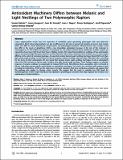Por favor, use este identificador para citar o enlazar a este item:
http://hdl.handle.net/10261/29483COMPARTIR / EXPORTAR:
 SHARE SHARE
 CORE
BASE CORE
BASE
|
|
| Visualizar otros formatos: MARC | Dublin Core | RDF | ORE | MODS | METS | DIDL | DATACITE | |

| Título: | Antioxidant machinery differs between melanic and light nestlings of two polymorphic raptors |
Autor: | Galván, Ismael CSIC ORCID ; Gangoso, Laura CSIC ORCID; Grande, Juan Manuel CSIC ORCID; Negro, Juan J. CSIC ORCID ; Rodríguez, Airam CSIC ORCID; Figuerola, Jordi CSIC ORCID ; Alonso-Álvarez, Carlos CSIC ORCID | Palabras clave: | Phenotypes Colours Falco eleonorae |
Fecha de publicación: | 14-oct-2010 | Editor: | Public Library of Science | Citación: | PLoS ONE 5(10): e13369 (2010) | Resumen: | Colour polymorphism results from the expression of multiallelic genes generating phenotypes with very distinctive colourations. Most colour polymorphisms are due to differences in the type or amount of melanins present in each morph, which also differ in several behavioural, morphometric and physiological attributes. Melanin-based colour morphs could also differ in the levels of glutathione (GSH), a key intracellular antioxidant, because of the role of this molecule in melanogenesis. As GSH inhibits the synthesis of eumelanin (i.e. the darkest melanin form), individuals of darker morphs are expected to have lower GSH levels than those of lighter morphs. We tested this prediction in nestlings of two polymorphic raptors, the booted eagle Hieraaetus pennatus and the Eleonora's falcon Falco eleonorae, both of which occur in two morphs differing in the extent of eumelanic plumage. As expected, melanic booted eagle nestlings had lower blood GSH levels than light morph eagle nestlings. In the Eleonora's falcon, however, melanic nestlings only had lower GSH levels after controlling for the levels of other antioxidants. We also found that melanic female eagle nestlings had higher levels of antioxidants other than GSH and were in better body condition than light female eagle nestlings. These findings suggest an adaptive response of melanic nestlings to compensate for reduced GSH levels. Nevertheless, these associations were not found in falcons, indicating species-specific particularities in antioxidant machinery. Our results are consistent with previous work revealing the importance of GSH on the expression of melanic characters that show continuous variation, and suggest that this pathway also applies to discrete colour morphs. We suggest that the need to maintain low GSH levels for eumelanogenesis in dark morph individuals may represent a physiological constraint that helps regulate the evolution and maintenance of polymorphisms. | Versión del editor: | http://dx.doi.org/10.1371/journal.pone.0013369 | URI: | http://hdl.handle.net/10261/29483 | DOI: | 10.1371/journal.pone.0013369 | E-ISSN: | 1932-6203 |
| Aparece en las colecciones: | (EBD) Artículos (IREC) Artículos |
Ficheros en este ítem:
| Fichero | Descripción | Tamaño | Formato | |
|---|---|---|---|---|
| journal.pone.0013369.pdf | 1,4 MB | Adobe PDF |  Visualizar/Abrir |
CORE Recommender
PubMed Central
Citations
8
checked on 20-mar-2024
SCOPUSTM
Citations
32
checked on 17-abr-2024
WEB OF SCIENCETM
Citations
30
checked on 26-feb-2024
Page view(s)
452
checked on 18-abr-2024
Download(s)
281
checked on 18-abr-2024

